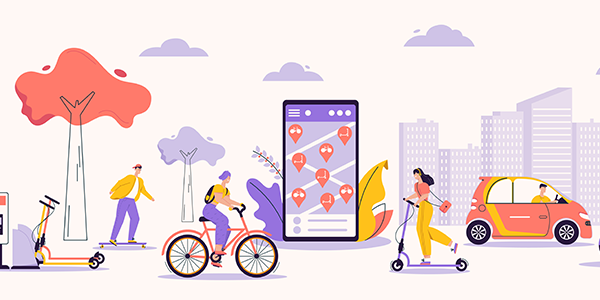
The new last mile: parkmobile instead of micromobile
Even the longest journey begins with the first step, it is said. What the legendary Chinese philosopher Laozi, to whom this wisdom is attributed, did not elaborate: Every path ends with the last step. And - to stay with the metaphor - it can actually only end where the walkers can put down their shoes.
What does this have to do with urban mobility? Many destinations, especially those in inner-city locations, offer few, no or at least expensive parking facilities for cars. The last step to the destination - or the last mile, as transportation planners call it - is therefore increasingly being seen as both a challenge and an opportunity for planners, drivers and also urban society.
Many interests, some of them conflicting, are involved in this last mile: Many municipalities would like to reduce the number of parking spaces and car traffic in general, retailers value good accessibility by individual means of transport, city dwellers and visitors increasingly enjoy car-free traffic areas, and drivers in turn would like to roll directly to their destination.
"Unfortunately, we have to stay outside" - is that the answer?
Can there be common solutions for such divergent demands? If so, then according to the general reading, only without the car. The car must stay outside. It must be parked on the outskirts of the city, outside the residential area, at park-and-ride hubs or wherever.
The supposed magic formula for realizing this claim is called micromobility: the last 1,000 meters from the streetcar stop to the workplace by electric stand-up scooter. The trip to the city park during lunch break with a bike from bike sharing. The way from the S-Bahn to the pub district with a hoverboard.
Or as the German Institute of Urban Affairs [1] puts it: "Micromobility is locomotion with electrically motorized as well as non-motorized micro and light vehicles, also called electric micro vehicles. These include e-treadooters or e-scooters, pedal scooters, segways, e-light vehicles, hoverboards, monowheels, and also e-skateboards and classic skateboards. All these means of transportation are lightweight, compact and primarily designed for individual mobility. ... The greatest potential is seen in their use as feeders on the first or last mile in interaction with public transport, for example to link the surrounding areas, the outskirts and the city center."
The supply of such small, smart, freely available vehicles in the inner cities has really exploded in recent years. But are these micro-vehicles really suitable for providing a comprehensive service for the last mile? Are they really suitable for everyone - including the less digital or those with physical impairments? And is it especially attractive for drivers to switch from a safe, air-conditioned, dry and multimedia-equipped car to e-trekkers?
Micromobility currently hardly replaces a car trip
There is no light without shadow. The longed-for world of micromobility - no emissions, hardly any land consumption, peaceful coexistence of all transport participants - cannot be fully realized in reality. A headline like "Over 50% reduce car trips" of the Micromobility Study 2023 [2] suggests that the exuberant supply of small vehicles can halve car traffic in the last mile. In fact, however, the study merely asked whether people still use their cars as intensively after purchasing a light electric vehicle (LEV) [3]. They don't. Aha ... Even according to the e-scooter rental company voi, only twelve percent of all journeys in German-speaking countries will replace a car journey in 2021. [4] Business mobility service provider Alphabet notes, "In practice, however, there is no concrete evidence that the rise of e-scooters has led to a decline in car ownership or emissions."[5]
So the potential remains unproven. What's more, even with micromobility, parking remains an issue. Lucky if you can take your own hoverboard to the office. It's hardly the rule.
There is no doubt that light and micro vehicles for certain purposes have their justification, their market and their fans. But there is still some evidence to suggest that they will remain the exception for a true last mile. Perhaps autonomous on-demand shuttles can provide new impetus at some point in the future. So if, despite micromobility, the question of the last mile is just as open as it was in the past, we should look for further approaches to make it more "city-friendly."
And a look at reality helps here: there are still many people who, for good reasons, would like to drive the entire route, including the first and last mile, by car. Be it because of weather safety, larger luggage, lack of availability of sharing vehicles, multiple passengers, plans for major purchases, time constraints, etc. As long as there is freedom of choice between modes of transport, there is a lot to be said for the car. Except for the urban parking situation mentioned at the beginning.
But what if it were possible to cover the last mile by car and still achieve a comparable effect to that promised by e-scooters and the like?
Smart parking management meets many last mile requirements
Because what is really at stake in the last mile? What is generally desired is less car traffic in city centers, consequently less emissions, more space for road users without cars, a higher urban quality of life. Often, less urban space should be occupied by parking areas. And individually, all road users could gain flexibility and perhaps even time. There is probably a broad consensus that these are all desirable effects.
We dare to suggest that clever digitized parking management can contribute to the realization of all these objectives. After all, cities generally have numerous privately managed parking spaces that are only partially utilized or only utilized at certain times. If these spaces were dynamized and thus optimally occupied, and the authorizations for them were distributed online or booked in advance, drivers could access them directly. Without having to search for a parking space, without on-street parking, without having to change cars.
Such a system can be implemented using digital parking management with parkoneer. The parking areas of companies, mixed-use properties, shopping centers, etc. managed with the parkoneer solution have all the prerequisites for this due to the high transparency of their use. Since cameras record every entrance and exit, not only the current occupancy is known. Patterns such as occupancy over the course of the day or over the days of the week can also be derived effortlessly. This also means that the system "knows" in advance how many parking spaces are empty at which times and can be released for parking space seekers.
Making unused parking spaces dynamic: a contribution to traffic avoidance
And here we come full circle to the last mile: Anyone who books these free spaces online - whether as an individual, via employers or via the respective institution visited - drives off with the certainty of finding a parking space close to their destination. Advantages for car drivers: There is no need to switch to other modes of transport and the associated uncertainty, inconvenience and loss of time. Benefits for people in cities: Emissions-intensive parking search traffic is eliminated, no on-street parking spaces are needed or occupied - and sidewalks remain free of micro-vehicles. Benefit for businesses that open their parking lots in this way: They have optimal control options via parkoneer's digital dashboard, can reliably assure their own stakeholders of parking spaces, and can even monetize their otherwise unused parking capacity.
But doesn't such simplification create even more car traffic instead of less? No, because if taken to its logical conclusion, such a digital solution also works hand in hand with urban planning that aims to equalize traffic. Ultimately, only those drivers who have booked a parking space will head for the city center. The result: urban traffic areas are hardly burdened any more. And how could the question of the last mile be answered more cleverly?
Sources
[1] https://difu.de/nachrichten/was-ist-eigentlich-mikromobilitaet
[2]https://www.presseportal.de/pm/79936/5517726
[3] https://shop.voylt.com/blog/leichtfahrzeug-lev/
[4] https://www.voi.com/blog/sustainable-transport-micromobility-debunking-myths/
[5] https://www.alphabet.com/de-at/mikromobilitaet-und-der-trend-der-letzten-meile

